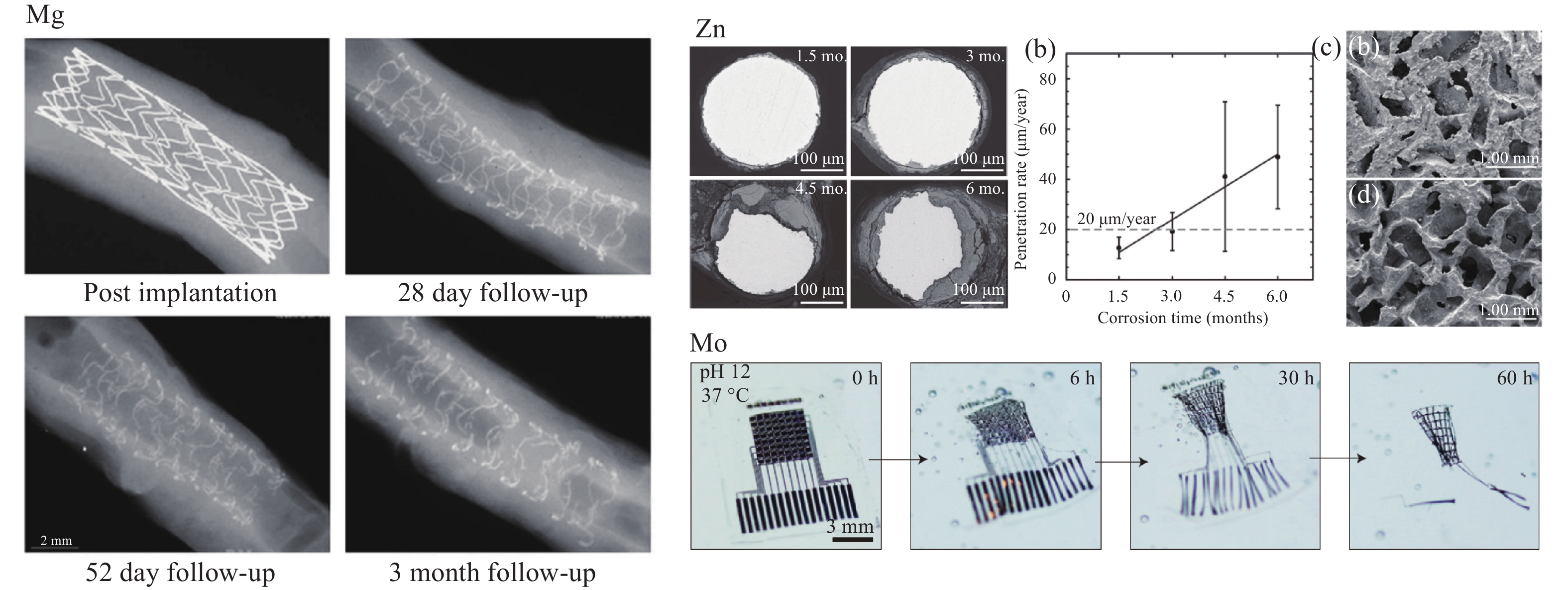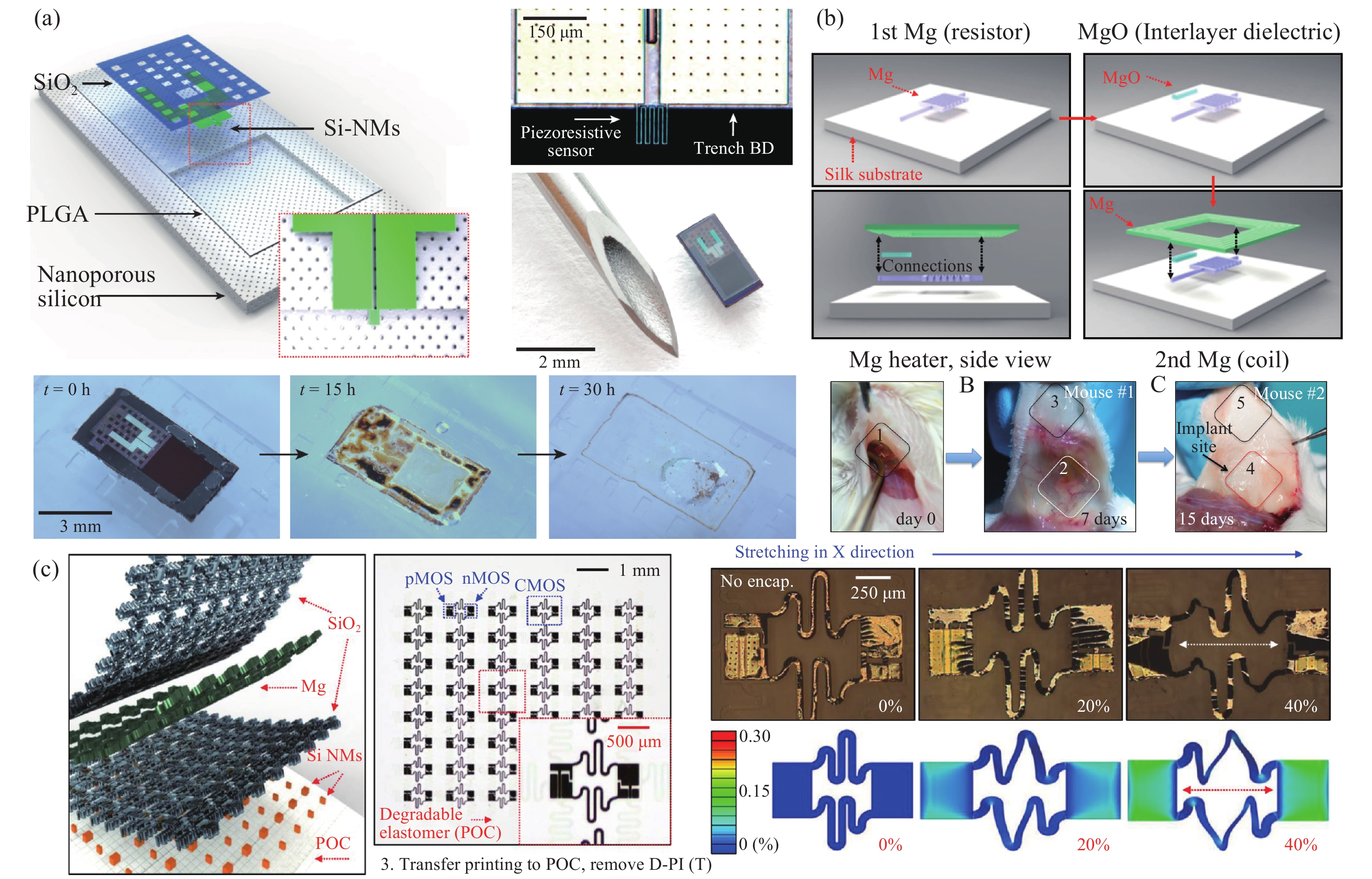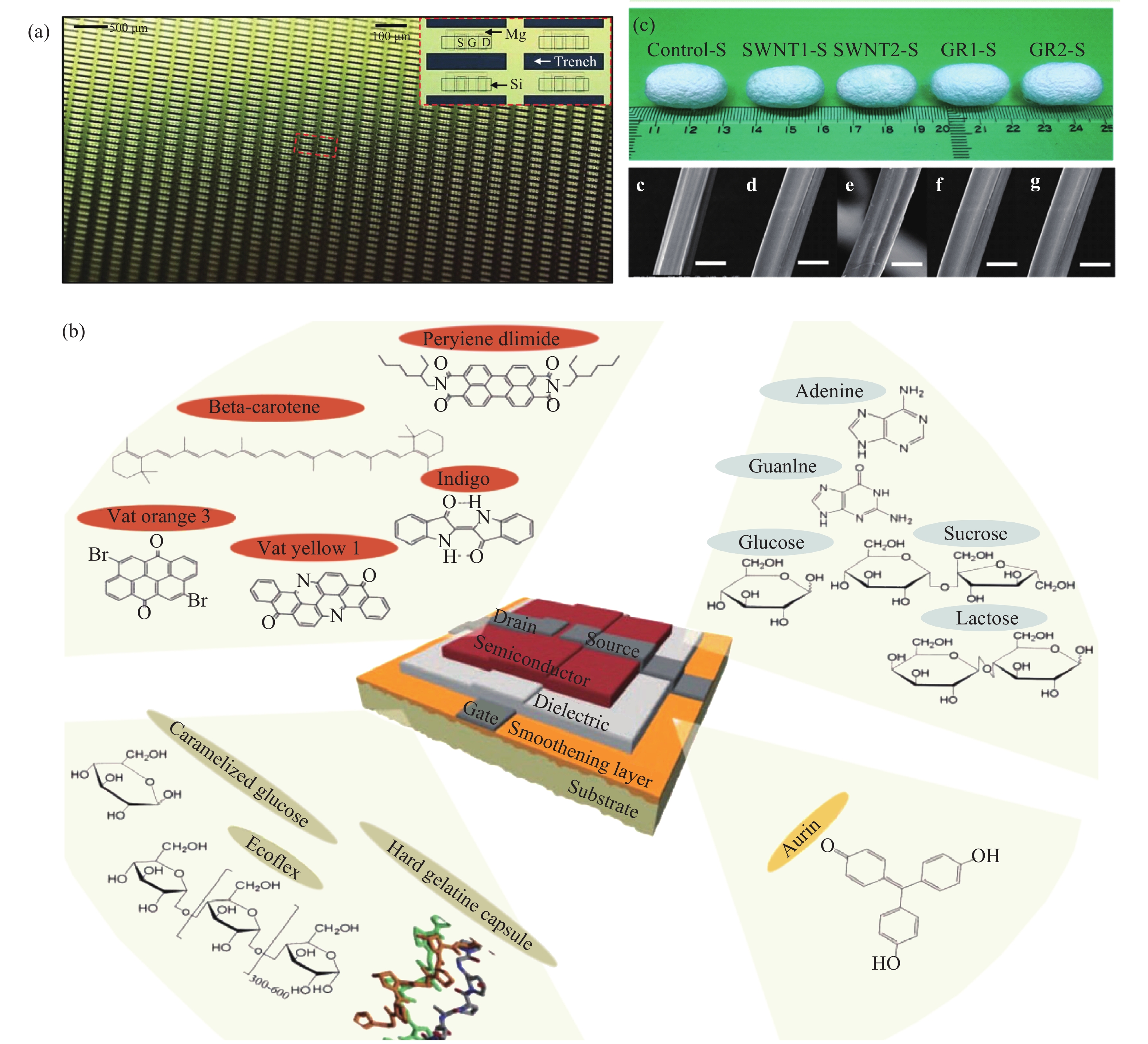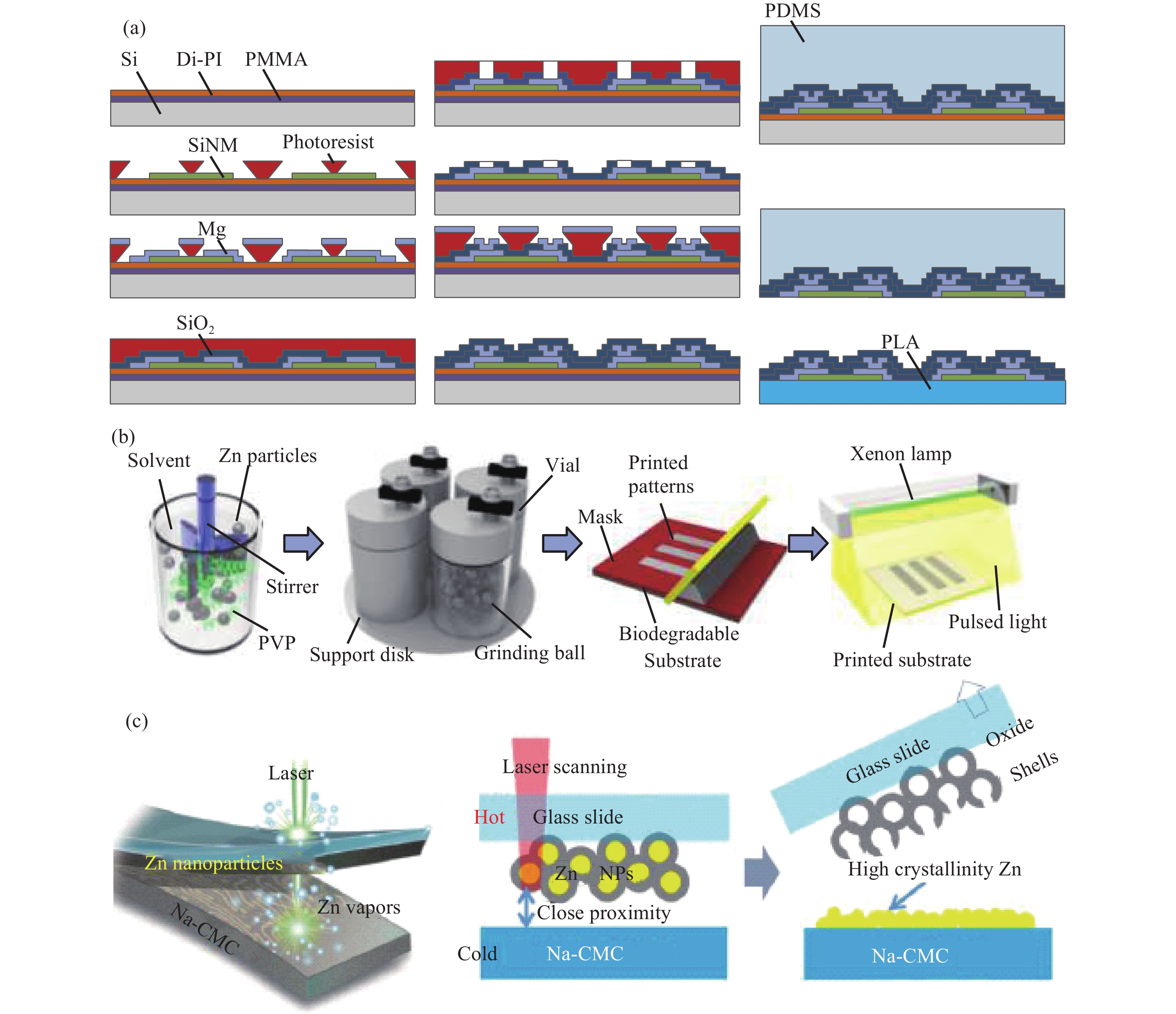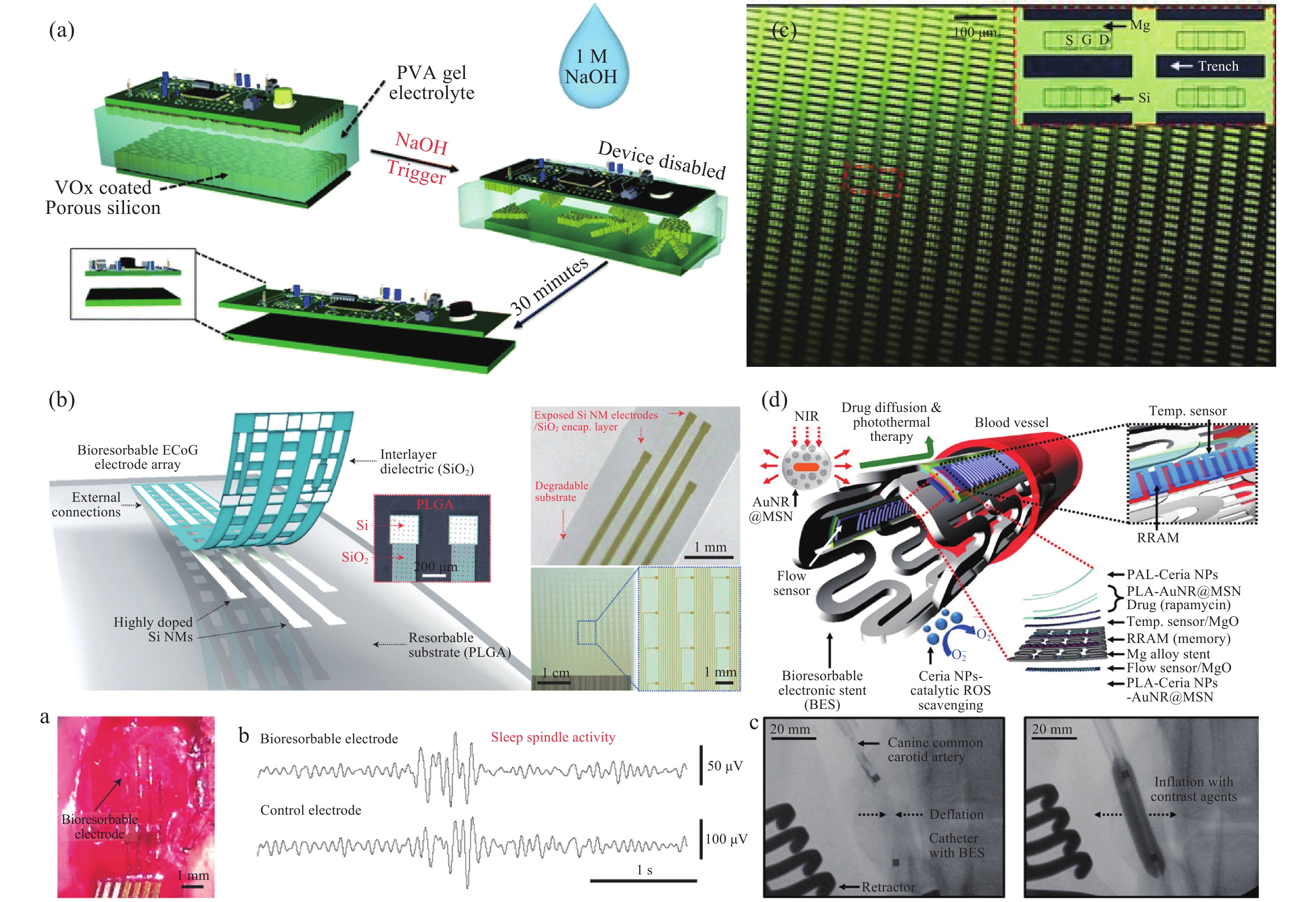| Citation: |
Xian Huang. Materials and applications of bioresorbable electronics[J]. Journal of Semiconductors, 2018, 39(1): 011003. doi: 10.1088/1674-4926/39/1/011003
****
X Huang, Materials and applications of bioresorbable electronics[J]. J. Semicond., 2018, 39(1): 011003. doi: 10.1088/1674-4926/39/1/011003.
|
Materials and applications of bioresorbable electronics
DOI: 10.1088/1674-4926/39/1/011003
More Information
-
Abstract
Bioresorbable electronics is a new type of electronics technology that can potentially lead to biodegradable and dissolvable electronic devices to replace current built-to-last circuits predominantly used in implantable devices and consumer electronics. Such devices dissolve in an aqueous environment in time periods from seconds to months, and generate biological safe products. This paper reviews materials, fabrication techniques, and applications of bioresorbable electronics, and aims to inspire more revolutionary bioresorbable systems that can generate broader social and economic impact. Existing challenges and potential solutions in developing bioresorbable electronics have also been presented to arouse more joint research efforts in this field to build systematic technology framework. -
References
[1] Hwang S W, Tao H, Kim D H, et al. A physically transient form of silicon electronics. Science, 2012, 337(6102): 1640 doi: 10.1126/science.1226325[2] Kim D H, Viventi J, Amsden J J, et al. Dissolvable films of silk fibroin for ultrathin conformal bio-integrated electronics. Nat Mater, 2010, 9(6): 511 doi: 10.1038/nmat2745[3] Mannoor M S, Tao H, Clayton J D, et al. Graphene-based wireless bacteria detection on tooth enamel. Nat Commun, 2012, 3: 763 doi: 10.1038/ncomms1767[4] Yin L, Cheng H Y, Mao S M, et al. Dissolvable metals for transient electronics. Adv Funct Mater, 2014, 24(5): 645 doi: 10.1002/adfm.201301847[5] Makadia H K, Siegel S J. Poly lactic-co-glycolic acid (PLGA) as biodegradable controlled drug delivery carrier. Polymers (Basel), 2011, 3(3): 1377[6] Kang S K, Hwang S W, Cheng H Y, et al. Dissolution behaviors and applications of silicon oxides and nitrides in transient electronics. Adv Funct Mater, 2014, 24(28): 4427 doi: 10.1002/adfm.v24.28[7] Hwang S W, Kang S K, Huang X, et al. Materials for programmed, functional transformation in transient electronic systems. Adv Mater, 2015, 27(1): 47 doi: 10.1002/adma.v27.1[8] Hwang S W, Huang X, Seo J H, et al. Materials for bioresorbable radio frequency electronics. Adv Mater, 2013, 25(26): 3526 doi: 10.1002/adma.201300920[9] Hwang S W, Song J K, Huang X, et al. High-performance biodegradable/transient electronics on biodegradable polymers. Adv Mater, 2014, 26(23): 3905 doi: 10.1002/adma.201306050[10] Spalvins E, Dubey B, Townsend T. Impact of electronic waste disposal on lead concentrations in landfill leachate. Environ Sci Technol, 2008, 42(19): 7452 doi: 10.1021/es8009277[11] Babu B R, Parande A K, Basha S A. Electrical and electronic waste: a global environmental problem. Waste Manage Res, 2007, 25(4): 307 doi: 10.1177/0734242X07076941[12] Morf L S, Tremp J, Gloor R, et al. Brominated flame retardants in waste electrical and electronic equipment: substance flows in a recycling plant. Environ Sci Technol, 2005, 39(22): 8691 doi: 10.1021/es051170k[13] Kirkland N T. Magnesium biomaterials: past, present and future. Corros Eng, Sci Technol, 2012, 47(5): 322 doi: 10.1179/1743278212Y.0000000034[14] Song G L, Song S Z. A possible biodegradable magnesium implant material. Adv Eng Mater, 2007, 9(4): 298 doi: 10.1002/(ISSN)1527-2648[15] Pierson D, Edick J, Tauscher A, et al. A simplified in vivo approach for evaluating the bioabsorbable behavior of candidate stent materials. J Biomedl Mater Res B, 2012, 100B(1): 58 doi: 10.1002/jbm.b.v100b.1[16] Wong H M, Yeung K W K, Lam K O, et al. A biodegradable polymer-based coating to control the performance of magnesium alloy orthopaedic implants. Biomaterials, 2010, 31(8): 2084 doi: 10.1016/j.biomaterials.2009.11.111[17] Li M, Cheng Y, Zheng Y F, et al. Surface characteristics and corrosion behaviour of WE43 magnesium alloy coated by SiC film. Appl Surf Sci, 2012, 258(7): 3074 doi: 10.1016/j.apsusc.2011.11.040[18] Hu J Y, Li Q, Zhong X K, et al. Novel anti-corrosion silicon dioxide coating prepared by sol–gel method for AZ91D magnesium alloy. Prog Org Coat, 2008, 63(1): 13 doi: 10.1016/j.porgcoat.2008.03.003[19] Bowen P K, Drelich J, Goldman J. Zinc exhibits ideal physiological corrosion behavior for bioabsorbable stents. Adv Mater, 2013, 25(18): 2577 doi: 10.1002/adma.201300226[20] Liu X W, Sun J K, Yang Y H, et al. In vitro investigation of ultra-pure Zn and its mini-tube as potential bioabsorbable stent material. Mater Lett, 2015, 161: 53 doi: 10.1016/j.matlet.2015.06.107[21] Zhao L C, Zhang Z, Song Y T, et al. Mechanical properties and in vitro biodegradation of newly developed porous Zn scaffolds for biomedical applications. Mater Des, 2016, 108: 136 doi: 10.1016/j.matdes.2016.06.080[22] Huang X, Liu Y H, Hwang S W, et al. Biodegradable materials for multilayer transient printed circuit boards. Adv Mater, 2014, 26(43): 7371 doi: 10.1002/adma.v26.43[23] Yu K J, Kuzum D, Hwang S W, et al. Bioresorbable silicon electronics for transient spatiotemporal mapping of electrical activity from the cerebral cortex. Nat Mater, 2016, 15: 782 doi: 10.1038/nmat4624[24] Lee C H, Kim H, Harburg D V, et al. Biological lipid membranes for on-demand, wireless drug delivery from thin, bioresorbable electronic implants. NPG Asia Mater, 2015, 7: e227 doi: 10.1038/am.2015.114[25] Slottow T L P, Pakala R, Okabe T, et al. Optical coherence tomography and intravascular ultrasound imaging of bioabsorbable magnesium stent degradation in porcine coronary arteries. Cardiovascular Revascularization Medicine, 2008, 9(4): 248 doi: 10.1016/j.carrev.2008.04.001[26] Rancan F, Papakostas D, Hadam S, et al. Investigation of polylactic acid (PLA) nanoparticles as drug delivery systems for local dermatotherapy. Pharm Res, 2009, 26(8): 2027 doi: 10.1007/s11095-009-9919-x[27] Oksman K, Skrifvars M, Selin J F. Natural fibres as reinforcement in polylactic acid (PLA) composites. Compos Sci Technol, 2003, 63(9): 1317 doi: 10.1016/S0266-3538(03)00103-9[28] Cheng Y L, Deng S B, Chen P, et al. Polylactic acid (PLA) synthesis and modifications: a review. Front Chem Chin, 2009, 4(3): 259 doi: 10.1007/s11458-009-0092-x[29] Shawe S, Buchanan F, Harkin-Jones E, et al. A study on the rate of degradation of the bioabsorbable polymer polyglycolic acid (PGA). J Mater Sci, 2006, 41(15): 4832 doi: 10.1007/s10853-006-0064-1[30] Sarkar S, Lee G Y, Wong J Y, et al. Development and characterization of a porous micro-patterned scaffold for vascular tissue engineering applications. Biomaterials, 2006, 27(27): 4775 doi: 10.1016/j.biomaterials.2006.04.038[31] Lü J M, Wang X W, Marin-Muller C, et al. Current advances in research and clinical applications of PLGA-based nanotechnology. Expert Rev Mol Diagns, 2009, 9(4): 325 doi: 10.1586/erm.09.15[32] de Valence S, Tille J C, Mugnai D, et al. Long term performance of polycaprolactone vascular grafts in a rat abdominal aorta replacement model. Biomaterials, 2012, 33(1): 38 doi: 10.1016/j.biomaterials.2011.09.024[33] Lee KK H, Kim H Y, Khil M S, et al. Characterization of nano-structured poly(ε-caprolactone) nonwoven mats via electrospinning. Polymer, 2003, 44(4): 1287 doi: 10.1016/S0032-3861(02)00820-0[34] Tan L L, Yu X M, Wan P, et al. Biodegradable materials for bone repairs: a review. J Mater Sci Technol, 2013, 29(6): 503 doi: 10.1016/j.jmst.2013.03.002[35] Tang Z G, Black R A, Curran J M, et al. Surface properties and biocompatibility of solvent-cast poly[ε-caprolactone] films. Biomaterials, 2004, 25(19): 4741 doi: 10.1016/j.biomaterials.2003.12.003[36] Hu J, Prabhakaran M P, Tian L L, et al. Drug-loaded emulsion electrospun nanofibers: characterization, drug release and in vitro biocompatibility. RSC Adv, 2015, 5(121): 100256 doi: 10.1039/C5RA18535A[37] Campana A, Cramer T, Simon D T, et al. Electrocardiographic recording with conformable organic electrochemical transistor fabricated on resorbable bioscaffold. Adv Mater, 2014, 26(23): 3874 doi: 10.1002/adma.201400263[38] Son D, Lee J, Jun Lee D J, et al. Bioresorbable electronic stent integrated with therapeutic nanoparticles for endovascular diseases. ACS Nano, 2015, 9(6): 5937 doi: 10.1021/acsnano.5b00651[39] Yin L, Huang X, Xu H X, et al. Materials, designs, and operational characteristics for fully biodegradable primary batteries. Adv Mater, 2014, 26(23): 3879 doi: 10.1002/adma.201306304[40] Kang S K, Murphy R K J, Hwang S W, et al. Bioresorbable silicon electronic sensors for the brain. Nature, 2016, 530(7588): 71 doi: 10.1038/nature16492[41] Yin G B, Zhang Y Z, Wang S D, et al. Study of the electrospun PLA/silk fibroin-gelatin composite nanofibrous scaffold for tissue engineering. J Biomed Mater Res A, 2010, 93(1): 158[42] Li M Y, Mondrinos M J, Chen X S, et al. Co-electrospun poly (lactide-co-glycolide), gelatin, and elastin blends for tissue engineering scaffolds. J Biomed Mater Res A, 2006, 79(4): 963[43] Zhang Y Z, Ouyang H W, Lim C T, et al. Electrospinning of gelatin fibers and gelatin/PCL composite fibrous scaffolds. J Biomed Mater Res B, 2005, 72(1): 156[44] n Jeon D B, Bak J Y, Yoon S M. Oxide thin-film transistors fabricated using biodegradable gate dielectric layer of chicken albumen. Jpn J Appl Phys, 2013, 52(12R): 128002 doi: 10.7567/JJAP.52.128002[45] Capelli R, Amsden J J, Generali G, et al. Integration of silk protein in organic and light-emitting transistors. Org Electron, 2011, 12(7): 1146 doi: 10.1016/j.orgel.2011.04.005[46] Mao L K, Hwang J C, Chang T H, et al. Pentacene organic thin-film transistors with solution-based gelatin dielectric. Org Electron, 2013, 14(4): 1170 doi: 10.1016/j.orgel.2013.02.010[47] Im H, Huang X J, Gu B, et al. A dielectric-modulated field-effect transistor for biosensing. Nature Nanotechnol, 2007, 2(7): 430 doi: 10.1038/nnano.2007.180[48] Cid C C, Riu J, Maroto A, et al. Carbon nanotube field effect transistors for the fast and selective detection of human immunoglobulin G. Analyst, 2008, 133(8): 1005 doi: 10.1039/b805301b[49] Park K Y, Sohn Y S, Kim C K, et al. Development of FET-type albumin sensor for diagnosing nephritis. Biosens Bioelectron, 2008, 23(12): 1904 doi: 10.1016/j.bios.2008.03.011[50] Wang Y D, Ameer G A, Sheppard B J, et al. A tough biodegradable elastomer. Nat Biotech, 2002, 20(6): 602 doi: 10.1038/nbt0602-602[51] Boutry C M, Nguyen A, Lawal Q Q, et al. Fully biodegradable pressure sensor, viscoelastic behavior of PGS dielectric elastomer upon degradation. 2015 IEEE Sensors, 2015: 1[52] Yang J, Webb A R, Ameer G A. Novel citric acid-based biodegradable elastomers for tissue engineering. Adv Mater, 2004, 16(6): 511 doi: 10.1002/(ISSN)1521-4095[53] Hwang S W, Lee C H, Cheng H Y, et al. Biodegradable elastomers and silicon nanomembranes/nanoribbons for stretchable, transient electronics, and biosensors. Nano Lett, 2015, 15(5): 2801 doi: 10.1021/nl503997m[54] Tao H, Hwang S W, Marelli B, et al. Silk-based resorbable electronic devices for remotely controlled therapy and in vivo infection abatement. Proc Natl Acad Sci, 2014, 111(49): 17385 doi: 10.1073/pnas.1407743111[55] Birchall J D, Chappell J S. The chemistry of aluminum and silicon in relation to Alzheimer's disease. Clin Chem, 1988, 34(2): 265[56] Finnie K S, Waller D J, Perret F L, et al. Biodegradability of sol–gel silica microparticles for drug delivery. J Sol-Gel Sci Technol, 2009, 49(1): 12 doi: 10.1007/s10971-008-1847-4[57] Kang S K, Hwang S W, Cheng H Y, et al. Dissolution behaviors and applications of silicon oxides and nitrides in transient electronics. Adv Funct Mater, 2014, 24(28): 4427 doi: 10.1002/adfm.v24.28[58] Li F M, Nathan A, Wu Y L, et al. Organic thin-film transistor integration using silicon nitride gate dielectric. Appl Phys Lett, 2007, 90(13): 133514 doi: 10.1063/1.2718505[59] She M, Takeuchi H, King T J. Silicon-nitride as a tunnel dielectric for improved SONOS-type flash memory. IEEE Electron Device Lett, 2003, 24(5): 309 doi: 10.1109/LED.2003.812547[60] Mejias J A, Berry A J, Refson K, et al. The kinetics and mechanism of MgO dissolution. Chem Phys Lett, 1999, 314(5/6): 558[61] Fedoročková A, Raschman P. Effects of pH and acid anions on the dissolution kinetics of MgO. Chem Eng J, 2008, 143(1-3): 265 doi: 10.1016/j.cej.2008.04.029[62] Yan L, Lopez C M, Shrestha R P, et al. Magnesium oxide as a candidate high-κ gate dielectric. Appl Phys Lett, 2006, 88(14): 142901 doi: 10.1063/1.2191419[63] Posadas A, Walker F J, Ahn C H, et al. Epitaxial MgO as an alternative gate dielectric for SiC transistor applications. Appl Phys Lett, 2008, 92(23): 233511 doi: 10.1063/1.2944865[64] Jagannathan H, Narayanan V, Brown S. Engineering high dielectric constant materials for band-edge CMOS applications. ECS Trans, 2008, 16(5): 19[65] Kang S K, Park G, Kim K, et al. Dissolution chemistry and biocompatibility of silicon- and germanium-based semiconductors for transient electronics. ACS Appl Mater Interf, 2015, 7(17): 9297 doi: 10.1021/acsami.5b02526[66] Hwang S W, Park G, Edwards C, et al. Dissolution chemistry and biocompatibility of single-crystalline silicon nanomembranes and associated materials for transient electronics. ACS Nano, 2014, 8(6): 5843 doi: 10.1021/nn500847g[67] Rosenberg B. The effect of oxygen adsorption on photo-and semiconduction of β-carotene. J Chem Phys, 1961, 34(3): 812 doi: 10.1063/1.1731680[68] Chen S Y, Lu Y Y, Shih F Y, et al. Biologically inspired graphene-chlorophyll phototransistors with high gain. Carbon, 2013, 63: 23 doi: 10.1016/j.carbon.2013.06.031[69] Irimia-Vladu M, Troshin P A, Reisinger M, et al. Biocompatible and biodegradable materials for organic field-effect transistors. Adv Funct Mater, 2010, 20(23): 4069 doi: 10.1002/adfm.201001031[70] Ling M M, Erk P, Gomez M, et al. Air-stable n-channel organic semiconductors based on perylene diimide derivatives without strong electron withdrawing groups. Adv Mater, 2007, 19(8): 1123 doi: 10.1002/(ISSN)1521-4095[71] Irimia-Vladu M, Głowacki E D, Troshin P A, et al. Indigo - a natural pigment for high performance ambipolar organic field effect transistors and circuits. Adv Mater, 2012, 24(3): 375 doi: 10.1002/adma.201102619[72] Mühl S, Beyer B. Bio-organic electronics—overview and prospects for the future. Electronics, 2014, 3(3): 444 doi: 10.3390/electronics3030444[73] Pan X Y, Yao P, Jiang M. Simultaneous nanoparticle formation and encapsulation driven by hydrophobic interaction of casein-graft-dextran and β-carotene. J Colloid Interf Sci, 2007, 315(2): 456 doi: 10.1016/j.jcis.2007.07.015[74] Ferruzzi M G, Blakeslee J. Digestion, absorption, and cancer preventative activity of dietary chlorophyll derivatives. Nutr Res, 2007, 27(1): 1 doi: 10.1016/j.nutres.2006.12.003[75] Irimia-Vladu M, Troshin P A. Environmentally sustainable organic field effect transistors. Org Electron, 2010, 11(12): 1974 doi: 10.1016/j.orgel.2010.09.007[76] Hwang S W, Kim D H, Tao H, et al. Materials and fabrication processes for transient and bioresorbable high-performance electronics. Adv Funct Mater, 2013, 23(33): 4087 doi: 10.1002/adfm.v23.33[77] Wang Q, Wang C Y, Zhang M C, et al. Feeding single-walled carbon nanotubes or graphene to silkworms for reinforced silk fibers. Nano Lett, 2016, 16(10): 6695 doi: 10.1021/acs.nanolett.6b03597[78] Bianco A, Kostarelos K, Prato M, Making carbon nanotubes biocompatible and biodegradable. Making carbon nanotubes biocompatible and biodegradable. Chem Commun, 2011, 47(37): 10182 doi: 10.1039/c1cc13011k[79] Mahajan B K, Yu X W, Shou W, et al. Mechanically milled irregular zinc nanoparticles for printable bioresorbable electronics. Small, 2017, 13(17): 1700065 doi: 10.1002/smll.201700065[80] Shou W, Mahajan B K, Ludwig B, et al. Low-cost manufacturing of bioresorbable conductors by evaporation–condensation-mediated laser printing and sintering of zn nanoparticles. Adv Mater, 2017, 29(26): 1700172 doi: 10.1002/adma.v29.26[81] Kim Y J, Chun S E, Whitacre J, et al. Self-deployable current sources fabricated from edible materials. J Mater Chem B, 2013, 1(31): 3781 doi: 10.1039/c3tb20183j[82] Jia X T, Yang Y, Wang C Y, et al. Biocompatible ionic liquid–biopolymer electrolyte-enabled thin and compact magnesium–air batteries. ACS Appl Mater Interf, 2014, 6(23): 21110 doi: 10.1021/am505985z[83] Douglas A, Muralidharan N, Carter R, et al. Ultrafast triggered transient energy storage by atomic layer deposition into porous silicon for integrated transient electronics. Nanoscale, 2016, 8(14): 7384 doi: 10.1039/C5NR09095D[84] Pal R K, Farghaly A A, Wang C Z, et al. Conducting polymer-silk biocomposites for flexible and biodegradable electrochemical sensors. Biosens Bioelectron, 2016, 81: 294 doi: 10.1016/j.bios.2016.03.010[85] Luo M, Martinez A W, Song C, et al. A microfabricated wireless rf pressure sensor made completely of biodegradable materials. J Microelectromechan Syst, 2014, 23(1): 4 doi: 10.1109/JMEMS.2013.2290111[86] Capelli R, Amsden J J, Generali G, et al. Integration of silk protein in organic and light-emitting transistors. Org Electron, 2011, 12(7): 1146 doi: 10.1016/j.orgel.2011.04.005[87] Irimia-Vladu M, Sariciftci N S, Bauer S. Exotic materials for bio-organic electronics. J Mater Chem, 2011, 21(5): 1350 doi: 10.1039/C0JM02444A -
Proportional views





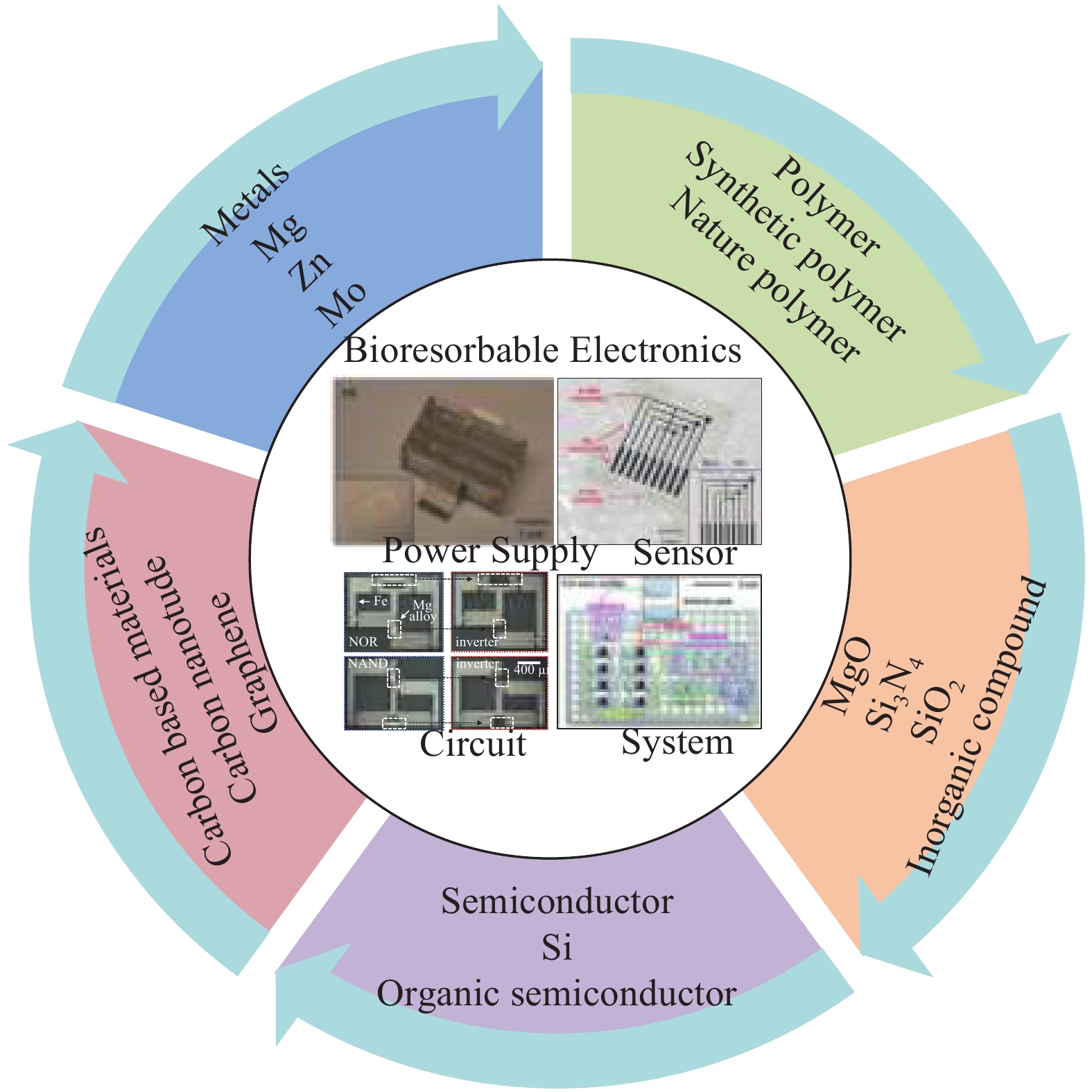
 DownLoad:
DownLoad:
